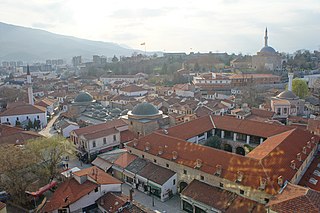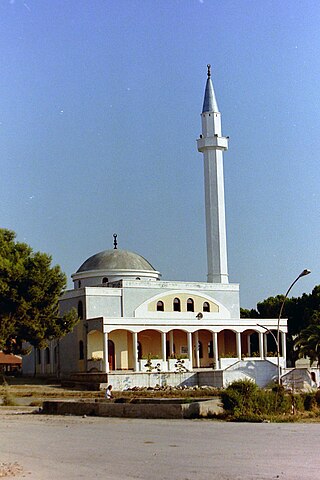
The White Tower of Thessaloniki is a monument and museum on the waterfront of the city of Thessaloniki, capital of the region of Macedonia in northern Greece. The present tower replaced an old Byzantine fortification, known to have been mentioned around the 12th century, that the Ottoman Empire reconstructed to fortify the city's fortress some time after Sultan Murad II captured Thessaloniki in 1430. During the period of Ottoman rule, the tower became a notorious prison and the scene of numerous mass executions, most famously of the Janissaries who revolted during the reign of Mahmud II.
Evrenos or Evrenuz was an Ottoman military commander. Byzantine sources mention him as Ἐβρενός, Ἀβρανέζης, Βρανέζης, Βρανεύς (?), Βρενέζ, Βρενέζης, Βρενές.

Mborje is a settlement in the Korçë County, southeastern Albania. At the 2015 local government reform it became part of the municipality Korçë. It is a southeastern suburb of Korçë.
The Battle of Savra or the Battle of the Vjosë was fought on 18 September 1385 between Ottoman and much smaller Zetan forces, at the Savra field near Lushnjë. The Ottomans were invited by Karl Thopia to support him in his feud against Balša II.

The Principality of Muzaka was an independent realm ruled by the Albanian Muzaka family with its capital at Berat, covering territories in Central and Southern Albania, Western Macedonia and Northern Greece. One of the first rulers was Andrea I Muzaka whose reign was recognized by the Byzantine Emperor. During the Battle of Savra, the Ottomans captured Berat from Balša II, together with Kruja and Ulcinj. They soon retreated from all of those towns keeping only Castoria under their permanent control. Some sources explain that Ottomans probably remained in Berat with intention to use it as foothold to capture Valona. By 1396 Muzaka family took over control of Berat. In 1417 the territories of the Principality, including Vlorë and Berat, became a part of the Ottoman Empire.

The Pashalik of Scutari, Iskodra, or Shkodra (1757–1831), was an autonomous and de facto independent pashalik created by the Buşatlı family from the previous Sanjak of Scutari, which was situated around the city of Shkodër in modern-day Albania and large majority of modern-day Montenegro. At its peak during the reign of Kara Mahmud Bushati the pashalik encompassed much of Albania, most of Kosovo, western Macedonia, southeastern Serbia and most of Montenegro. Up to 1830 the Pashalik of Shkodra controlled most of the above lands including Southern Montenegro.

The Peqin Castle is a castle in Peqin, Albania. In the Roman times the city was known by the name of Claudiana, an Illyrian-inhabited territory. The foundations of the castle are thought to date from the Roman period, the time of the construction of the Via Egnatia. Its walls at one point had a height of around 12 metres (39 ft). The castle was later rebuilt and expanded during the Turkish occupation of Albania, at which time it was passed into the control of the Sipahi (lord) of the local fief, who added a palace and a harem. The last resident of the castle was Demir Pasha.

The Ibrahim Pasha Mosque,, is the third-largest mosque on the Balkan Peninsula and the second-largest in Bulgaria. Located in the town of Razgrad, the mosque is one of the most exquisite examples of Ottoman classical architecture.

The Mosque Katip Sinan Qelebi, also known as "Katip Çelebi", is located on the Adem Jashari Street in Prizren, Kosovo. Katip means "secretary" in Turkish. It may be named after Katip Çelebi but it also may be named like the Plaošnik mosque in Ohrid, which was named after Sinaneddin Yusuf Çelebi, short form Sinan Çelebi, from the Ohrizâde family.

The Old Bazaar also known as Turkish Bazaar is a bazaar located in Skopje, North Macedonia, situated on the eastern bank of the Vardar River, stretching from the Stone Bridge to the Bit-Pazar and from the Skopje Fortress to the Serava river. The Old Bazaar falls primarily within the borders of Čair Municipality but a part of it is located in Centar Municipality. As one of the oldest and largest marketplaces in the Balkans, it has been Skopje's centre for trade and commerce since at least the 12th century.

The Abdurrahman Pasha Mosque, also known as the Clock Mosque and historically as the Old Peqin Mosque is a Cultural Monument of Albania, located in Peqin.
Qazim Baba also known as Kasim Baba of Kostur was a 15th-century holy man of Albanian origin. Standing on a hill of Kastoria, he is supposed to have converted many Christians to Islam during the Mehmed II period.

The Sanjak of Elbasan was one of the sanjaks of the Ottoman Empire. Its county town was Elbasan in Albania.

The Sanjak of Ohri was one of the sanjaks of the Ottoman Empire established in 1395. Part of it was located on the territory of the Lordship of Prilep, a realm in Macedonia ruled by the Ottoman vassal Prince Marko until his death in the Battle of Rovine.
Pavlo Kurtik was an Albanian or styled Slavo-Albanian feudal lord who held an Ottoman vilayet, an administrative unit in the Ottoman Empire similar to a county or shire, located between the Erzen and Shkumbin rivers in present-day Albania. While he was Christian, one of a few Christian lords in the Ottoman Empire, his sons converted in Islam and held various official titles throughout the Empire.

The Kubelie Mosque or Kapllan Beu Mosque is a historic mosque in Kavajë, Albania. This mosque was originally built here in 1735 under the Ottomans by Kapllan Beu. The Old Mosque, stood on the main street of the city, about 70m to the east of the current one.

The Fatih Sultan Mehmet Mosque, also known as the St. Stephen's Cathedral of Shkodër in Rozafa is a 13th-century building within the Rozafa Castle near Shkodër, Albania.

Faik Pasha Mosque, also known locally as the Imaret of Arta, is a historical Ottoman building located in the town of Arta, Epirus, in Greece. Named after the Ottoman conqueror of the city in 1449, the mosque formed a complex including baths, an imaret and a madrasa. It is one of the two surviving mosques in Arta, the other being the Feyzullah Mosque. It is under renovation works and is not currently open for worship.

The Ahmed III Mosque, also known as the Acrocorinth Mosque or the Ahmed Pasha Mosque, is an Ottoman mosque located in the fortress of the Acrocorinth, in the Peloponnese, Greece. Built on the site of an earlier 16th-century mosque, the monument was commissioned by Sultan Ahmed III after the Ottoman reconquest of 1715. It now lies in a mostly ruinous state, abandoned and neglected, however it did undergo some restoration work in 2000.

The Imaret of Komotini is an imaret complex in the town of Komotini, in the Western Thrace region of northern Greece, and is thought to be one of the oldest surviving Ottoman monuments in Europe. It is dated between the early 1360s and the end of the fourteenth century. Its was built by Ottoman conqueror Gazi Ahmed Evrenos near the eastern walls of the Byzantine Koumoutzedes Castle. Ever since 1999 the building has functioned as the Ecclesiastical Museum of the Metropolis of Maroneia and Komotini. Local tradition of Komotini has linked it to a previous Byzantine church dedicated to the Holy Wisdom in this specific location, and supposedly parts of the church were incorporated into the building.
















